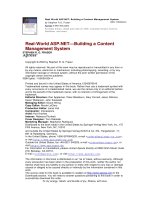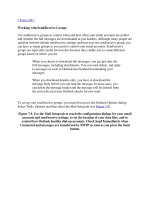Tài liệu Working with ASP Applications ppt
Bạn đang xem bản rút gọn của tài liệu. Xem và tải ngay bản đầy đủ của tài liệu tại đây (71.26 KB, 30 trang )
Working with ASP Applications
The various Component Object Model (COM) components, such as Microsoft® ActiveX® Data Objects
(ADO) 2.5 and CDO for Exchange 2000 Server (CDOEX) provide extensive libraries of constants in their
associated type libraries. Using the new Microsoft Internet Information Services (IIS) Web page keyword
METADATA, you can easily import these constants into your ASP applications and make them globally
available when you write scripts.
Note In Microsoft Exchange System Manager: Turn on Script Execute Permissions for ASP and Scripts
and Executables for Internet Server Application Programming Interface (ISAPI) filters. Otherwise, you will
get a 403 Permission Denied error.
To import these constants, you place a METADATA directive, such as the following, at the top of your ASP
file or in your GLOBAL.ASA file:
<!--METADATA TYPE="typelib" UUID="CD000000-8B95-11D1-82DB-00C04FB1625D"
NAME="CDO for Exchange 2000 Type Library" -->
<!--METADATA TYPE="typelib" UUID="CD001000-8B95-11D1-82DB-00C04FB1625D"
NAME="Microsoft CDO Workflow Objects for Microsoft Exchange"-->
<!--METADATA TYPE="typelib" UUID="25150F00-5734-11D2-A593-00C04F990D8A"
NAME="Microsoft CDO for Exchange Management Library"-->
<!--METADATA TYPE="typelib" UUID="00000205-0000-0010-8000-00AA006D2EA4"
NAME="ADODB Type Library" -->
This METADATA directive has the effect of importing the type information into the page at run time, so you
can use module constant names in your scripts without having to define them beforehand.
Example
<!--METADATA TYPE="typelib" UUID="CD000000-8B95-11D1-82DB-00C04FB1625D"
NAME="Microsoft CDO for Exchange 2000 Library" -->
<!--METADATA TYPE="typelib" UUID="CD001000-8B95-11D1-82DB-00C04FB1625D"
NAME="Microsoft CDO Workflow Objects for Microsoft Exchange"-->
<!--METADATA TYPE="typelib" UUID="25150F00-5734-11D2-A593-00C04F990D8A"
NAME="Microsoft CDO for Exchange Management Library"-->
<!--METADATA TYPE="typelib" UUID="00000205-0000-0010-8000-00AA006D2EA4"
NAME="ADODB Type Library" -->
<HTML>
<BODY>
<H1>Test the METADATA Directive Page</H1>
<p>Here are some of the field name string constants within CDOEX type library
:</p>
<H4>Some CDO for Exchange 2000 Server String Constants</H4>
<TABLE>
<TR><TD><b>cdoTo</b> </TD><TD><%=cdoTo%> </TD></TR>
<TR><TD><b>cdoFrom</b> </TD><TD><%=cdoFrom%> </TD></TR>
<TR><TD><b>cdoUTF_8</b></TD><TD><%=cdoUTF_8%></TD></TR>
</TABLE>
<H4>Some CDO for Exchange Enumeration Constants</H4>
<TABLE>
<TR><TD><b>cdoSendUsingPickup</b></TD><TD><%=cdoSendUsingPickup%>
</TD></TR>
<TR><TD><b>cdoSendUsingPort</b></TD><TD><%=cdoSendUsingPort%></TD></TR>
</TABLE>
<H4>Some ADO Enumeration Constants</H4>
<TABLE>
<TR><TD><b>adReadAll</b> </TD><TD><%=adReadAll%> </TD></TR>
<TR><TD><b>adReadLine</b> </TD><TD><%=adReadLine%> </TD></TR>
<TR><TD><b>adTypeBinary</b> </TD><TD><%=adTypeBinary%> </TD></TR>
<TR><TD><b>adTypeText</b> </TD><TD><%=adTypeText%> </TD></TR>
</TABLE>
</BODY>
</HTML>
To add type information from other type libraries, simply add another METADATA directive to the ASP file.
Putting these directives in your GLOBAL.ASA file makes all these constants available across the current
ASP application.
Working with ASP Applications
CDO for Windows 2000 and the ActiveX Data Objects (ADO) component provide extensive libraries of
constants within their associated type libraries. Using the new Internet Information Services (IIS) Web
page keyword METADATA, you can easily import these constants into your Active Server Pages (ASP)
applications and make them globally available when scripting.
To import these constants, you place a METADATA directive like the following at the top of your ASP file or
within your global.asa file:
<!--METADATA TYPE="typelib" UUID="CD000000-8B95-11D1-82DB-00C04FB1625D"
NAME="CDO for Windows 2000 Library" -->
<!--METADATA TYPE="typelib" UUID="00000205-0000-0010-8000-00AA006D2EA4"
NAME="ADODB Type Library" -->
This METADATA directive has the effect of importing the type information into the page at runtime, so you
can use module constant names within your scripts without having to define them before hand.
Example
<!--METADATA TYPE="typelib" UUID="CD000000-8B95-11D1-82DB-00C04FB1625D"
NAME="CDO for Windows 2000 Type Library" -->
<!--METADATA TYPE="typelib" UUID="00000205-0000-0010-8000-00AA006D2EA4"
NAME="ADODB Type Library" -->
<HTML>
<BODY>
<H1>Test the METADATA Directive Page</H1>
<p>Here are some of the field name string constants within CDOSYS
type library :</p>
<H4>Some CDO for Windows 2000 String Constants</H4>
<TABLE>
<TR><TD><b>cdoTo</b> </TD><TD><%=cdoTo%> </TD></TR>
<TR><TD><b>cdoFrom</b> </TD><TD><%=cdoFrom%> </TD></TR>
<TR><TD><b>cdoUTF_8</b></TD><TD><%=cdoUTF_8%></TD></TR>
</TABLE>
<H4>Some CDO for Windows 2000 Enumeration Constants</H4>
<TABLE>
<TR><TD><b>cdoSendUsingPickup</b></TD><TD><%=cdoSendUsingPickup%>
</TD></TR>
<TR><TD><b>cdoSendUsingPort</b></TD><TD><%=cdoSendUsingPort%></TD></TR>
</TABLE>
<H4>Some ADO Enumeration Constants</H4>
<TABLE>
<TR><TD><b>adReadAll</b> </TD><TD><%=adReadAll%> </TD></TR>
<TR><TD><b>adReadLine</b> </TD><TD><%=adReadLine%> </TD></TR>
<TR><TD><b>adTypeBinary</b> </TD><TD><%=adTypeBinary%> </TD></TR>
<TR><TD><b>adTypeText</b> </TD><TD><%=adTypeText%> </TD></TR>
</TABLE>
</BODY>
</HTML>
To add type information from other type libraries, simply add another METADATA directive to your ASP
file.
Putting these directives in your global.asa file makes all of these constants available across the
current ASP application.
Database Access Component
The Database Access Components (DAC) provide access to information stored in databases or other
tabular data structures. DAC includes ActiveX
®
Data Objects (ADO), Open Database Connectivity (ODBC),
and Object Linking and Embedding for Databases (OLEDB). ASP can use these components to easily
integrate information from a variety of database sources, like Microsoft® Access, SQL, Excel and other
technologies. Providing access to multiple types of data storage is called Universal Data Access.
For information about developing applications that use Universal Data Access see Universal Data Access
Web Site or the Microsoft Data Access SDK in the Platform SDK.
ADO is the most commonly used Data Access Component because of its ease of use. ADO has a library of
seven objects with methods and properties to help you access data. Each object can be created using
Server.CreateObject:
<%
' Create two of the seven ADO objects.
Set conn = Server.CreateObject("ADODB.Connection")
Set rs = Server.CreateObject("ADODB.RecordSet")
%>
Note
ADO uses a lot of constants that are pre-defined in a type library to keep the user from having to
remember specific values. To use the constants specified in the ADO Reference, you must either include a
file that contains information about the ADO constants, or include a reference to the ADO type library in
your Global.asa file. The following example demonstrates using the ADO type library to access constants.
For example, to use this line in an ASP file, you would have to remember that 3 indicates Open Static and
Lock Optimistic:
<% rs.Open "Customers", Conn, 3, 3 %>
If you include the type library for ADO, you could use this code:
<% rs.Open "Customers", Conn, adOpenStatic, adLockOptimistic %>
To include the following type library in your application, put this declaration in the Global.asa file.
<!-- METADATA TYPE="typelib" FILE="c:\program files\common
files\system\ado\msado20.dll"-->
Accessing a Data Source
ActiveX Data Objects (ADO) are an easy-to -use yet extensible technology for adding database access to
your Web pages. You can use ADO to write compact and scalable scripts for connecting to OLE DB
compliant data sources, such as databases, spreadsheets, sequential data files, or e-mail directories. OLE
DB is a system-level programming interface that provides standard set of COM interfaces for exposing
database management system functionality. With ADO's object model you can easily access these
interfaces (using scripting languages, such as VBScript or JScript) to add database functionality to your
Web applications. In addition, you can also use ADO to access Open Database Connectivity (ODBC)
compliant databases.
If you are a scripter with a modest understanding of database connectivity, you will find ADO's command
syntax uncomplicated and easy-to -use. If you are an experienced developer you will appreciate the
scalable, high-performance access ADO provides to a variety of data sources.
For more information about ADO, visit the Microsoft Universal Data Access (UDA) Web site.
Creating a Connection String
The first step in creating a Web data application is to provide a way for ADO to locate and identify your
data source. This is accomplished by means of a connection string, a series of semicolon delimited
arguments that define parameters such as the data source provider and the location of the data source.
ADO uses the connection string to identify the OLE DB provider and to direct the provider to the data
source. The provider is a component that represents the data source and exposes information to your
application in the form of rowsets.
The following table lists OLE DB connection strings for several common data sources:
Data Source OLE DB Connection String
Microsoft®
Access
Provider=Microsoft.Jet.OLEDB.4.0;Data
Source=physical path to .mdb file
Microsoft SQL
Server
Provider=SQLOLEDB.1;Data Source=path to
database on server
Oracle
Provider=MSDAORA.1;Data Source=path to
database on server
Microsoft
Indexing
Service
Provider=MSIDXS.1;Data Source=path to file
To provide for backward compatibility, the OLE DB Provider for ODBC supports ODBC connection string
syntax. The following table lists commonly used ODBC connection strings:
Data
Source
Driver
ODBC Connection String
Microsoft
Access
Driver={Microsoft Access Driver
(*.mdb)};DBQ=physical path to .mdb file
SQL
Server
DRIVER={SQL Server};SERVER=path to
server
Oracle
DRIVER={Microsoft ODBC for
Oracle};SERVER=path to server
Microsoft Driver={Microsoft Excel Driver
Excel (*.xls)};DBQ=physical path to .xls file;
DriverID=278
Microsoft
Excel 97
Driver={Microsoft Excel Driver
(*.xls)};DBQ=physical path to .xls
file;DriverID=790
Paradox
Driver={Microsoft Paradox Driver
(*.db)};DBQ=physical path to .db
file;DriverID=26
Text
Driver={Microsoft Text Driver
(*.txt;*.csv)};DBQ=physical path to .txt file
Driver={Microsoft Text Driver
(*.txt;*.csv)};DefaultDir=physical
path to .txt file
Microsoft
Visual
FoxPro®
(with a
database
container)
Driver={Microsoft Visual FoxPro
Driver};SourceType=DBC;SourceDb=physical
path to .dbc file
Microsoft
Visual
FoxPro
(without
a
database
container)
Driver={Microsoft Visual FoxPro
Driver};SourceType=DBF;SourceDb=physical
path to .dbf file
Note Connection strings that use a UNC path to refer to a data source located on a remote computer can
pose a potential security issue. To prevent unauthorized access of your data source, create a Windows
account for computers requiring access to the data and then apply appropriate NTFS permissions to the
data source.
Advanced Issues to Consider When Designing Web Data Applications
For performance and reliability reasons, it is strongly recommended that you use a client-server database
engine for the deployment of data driven Web applications that require high-demand access from more
than approximately 10 concurrent users. Although ADO works with any OLE DB compliant data source, it
has been extensively tested and is designed to work with client server databases such as Microsoft SQL
Server or Oracle.
ASP supports shared file databases (Microsoft Access or Microsoft FoxPro) as valid data sources. Although
some examples in the ASP documentation use a shared file database, it is recommended that these types
of database engines be used only for development purposes or limited deployment scenarios. Shared file
databases may not be as well suited as client-server databases for very high-demand, production-quality
Web applications.
If you are developing an ASP database application intended to connect to a remote SQL Server database
you should also be aware of the following issues:
• Choosing Connection Scheme for SQL Server You can choose between the TCP/IP Sockets
and Named Pipes methods for accessing a remote SQL Server database. With Named Pipes, database
clients must be authenticated by Windows before establishing a connection, raising the possibility that
a remote computer running named pipes might deny access to a user who has the appropriate SQL
Server access credentials, but does not have a Windows user account on that computer. Alternatively,
connections using TCP/IP Sockets connect directly to the database server, without connecting through
an intermediary computer—as is the case with Named Pipes. And because connections made with
TCP/IP Sockets connect directly to the database server, users can gain access through SQL Server
authentication, rather than Windows authentication.
• ODBC 80004005 Error If the connection scheme for accessing SQL Server is not set correctly,
users viewing your database application may receive an ODBC 80004005 error message. To correct
this situation, try using a local named pipe connection instead of a network named pipe connection if
SQL Server is running on the same computer as IIS. Windows XP security rules will not be enforced
because the pipe is a local connection rather than a network connection, which can be impersonated
by the anonymous user account. Also, in the SQL Server connection string (either in the Global.asa
file or in a page-level script), change the parameter SERVER=server name to SERVER=(local).
The keyword (local) is a special parameter recognized by the SQL Server ODBC driver. If this solution
does not work, then try to use a non-authenticated protocol between IIS and SQL Server, such as
TCP/IP sockets. This protocol will work when SQL Server is running locally or on remote computer.
Note To improve performance when connecting to a remote databases, use TCP/IP Sockets.
• SQL Server Security If you use SQL Server's Integrated or Mixed security features, and the SQL
Server database resides on a remote server, you will not be able to use integrated Windows
authentication. Specifically, you cannot forward integrated Windows authentication credentials to the
remote computer. This means that you may have to use Basic authentication, which relies on the
user to provide user name and password information.
For more information about these issues, visit the Microsoft Product Support Services Web site .
Connecting to a Data Source
ADO provides the Connection object for establishing and managing connections between your
applications and OLE DB compliant data sources or ODBC compliant databases. The Connection object
features properties and methods you can use to open and close database connections, and to issue
queries for updating information.
To establish a database connection, you first create an instance of the Connection object. For example,
the following script instantiates the Connection object and proceeds to open a connection:
<%
'Create a connection object.
Set cnn = Server.CreateObject("ADODB.Connection")
'Open a connection using the OLE DB connection string.
cnn.Open "Provider=Microsoft.Jet.OLEDB.4.0;Data
Source=C:\MarketData\ProjectedSales.mdb"
%>
Note The connection string does not contain spaces before or after the equal sign (=).
In this case, the Connection object's Open method refers to the connection string.
Executing SQL Queries with the Connection Object
With the Execute method of the Connection object you can issue commands to the data sources, such
as Structured Query Language (SQL) queries. (SQL, an industry standard language for communicating
with databases, defines commands for retrieving and updating information.) The Execute method can
accept parameters that specify the command (or query), the number of data records affected, and the
type of command being used.
The following script uses the Execute method to issue a query in the form of a SQL INSERT command,
which inserts data into a specific database table. In this case, the script block inserts the name Jose Lugo
into a database table named Customers.
<%
'Define the OLE DB connection string.
strConnectionString = "Provider=Microsoft.Jet.OLEDB.4.0;Data
Source=C:\Data\Employees.mdb"
'Instantiate the Connection object and open a database connection.
Set cnn = Server.CreateObject("ADODB.Connection")
cnn.Open strConnectionString
'Define SQL SELECT statement.
strSQL = "INSERT INTO Customers (FirstName, LastName) VALUES
('Jose','Lugo')"
'Use the Execute method to issue a SQL query to database.
cnn.Execute strSQL,,adCmdText + adExecuteNoRecords
%>
Note that two parameters are specified in the statement used to execute the query: adCmdText and
adExecuteNoRecords. The optional adCmdText parameter specifies the type of command, indicating
that the provider should evaluate the query statement (in this case, a SQL query) as a textual definition of
a command. The adExecuteNoRecords parameter instructs ADO to not create a set of data records if
there are no results returned to the application. This parameter works only with command types defined
as a text definition, such as SQL queries, or stored database procedures. Although the adCmdText and
adExecuteNoRecords parameters are optional, you should specify theses parameters when using the
Execute method to improve the performance of your data application.
Important ADO parameters, such as adCmdText, need to be defined before you can use them in a
script. A convenient way to define parameters is to use a component type library, which is a file containing
definitions for all ADO parameters. To implement a component type library, it must first be declared. Add
the following the <METADATA> tag to your .asp file or Global.asa file to declare the ADO type library:
<!--METADATA NAME="Microsoft ActiveX Data Objects 2.5 Library"
TYPE="TypeLib" UUID="{00000205-0000-0010-8000-00AA006D2EA4}"-->
For details about implementing component type libraries, see the Using Constants section of the Using
Variables and Constants topic.
In addition to the SQL INSERT command, you can use the SQL UPDATE and DELETE commands to
change and remove database information.
With the SQL UPDATE command you can change the values of items in a database table. The following
script uses the UPDATE command to change the Customers table's FirstName fields to Jeff for
every LastName field containing the last name Smith.
<%
Set cnn = Server.CreateObject("ADODB.Connection")
cnn.Open "Provider=Microsoft.Jet.OLEDB.4.0;Data
Source=C:\Data\Employees.mdb"
cnn.Execute "UPDATE Customers SET FirstName = 'Jeff' WHERE LastName =
'Smith' ",,adCmdText + adExecuteNoRecords
%>
To remove specific records from a database table, use the SQL DELETE command. The following script
removes all rows from the Customers table where the last name is Smith:
<%
Set cnn = Server.CreateObject("ADODB.Connection")
cnn.Open "Provider=Microsoft.Jet.OLEDB.4.0;Data
Source=C:\Data\Employees.mdb"
cnn.Execute "DELETE FROM Customers WHERE LastName =
'Smith'",,adCmdText + adExecuteNoRecords
%>
Note You must be careful when using the SQL DELETE command. A DELETE command without an
accompanying WHERE clause will delete all rows from a table. Be sure to include a SQL WHERE clause,
which specifies the exact rows to be deleted.
Using the Recordset Object for Manipulating Results
For retrieving data, examining results, and making changes to your database, ADO provides the
Recordset object. As its name implies, the Recordset object has features that you can use, depending
on your query constraints, for retrieving and displaying a set of database rows, or records. The Recordset
object maintains the position of each record returned by a query, thus enabling you to step through
results one item at a time.
Retrieving a Record Set
Successful Web data applications employ both the Connection object, to establish a link, and the
Recordset object, to manipulate returned data. By combining the specialized functions of both objects
you can develop database applications to carry out almost any data handling task. For example, the
following server-side script uses the Recordset object to execute a SQL SELECT command. The SELECT
command retrieves a specific set of information based on query constraints. The query also contains a SQL
WHERE clause, used to narrow down a query to a specific criterion. In this example, the WHERE clause
limits the query to all records containing the last name Smith from the Customers database ta ble.
<%
'Establish a connection with data source.
strConnectionString = "Provider=Microsoft.Jet.OLEDB.4.0;Data
Source=C:\Data\Employees.mdb"
Set cnn = Server.CreateObject("ADODB.Connection")
cnn.Open strConnectionString
'Instantiate a Recordset object.
Set rstCustomers = Server.CreateObject("ADODB.Recordset")
'Open a recordset using the Open method
'and use the connection established by the Connection object.
strSQL = "SELECT FirstName, LastName FROM Customers WHERE LastName =
'Smith' "
rstCustomers.Open strSQL, cnn
'Cycle through record set and display the results
'and increment record position with MoveNext method.
Set objFirstName = rstCustomers("FirstName")
Set objLastName = rstCustomers("LastName")
Do Until rstCustomers.EOF
Response.Write objFirstName & " " & objLastName & "<BR>"
rstCustomers.MoveNext
Loop
%>
Note that in the previous example, the Connection object established the database connection, and the
Recordset object used the same connection to retrieve results from the database. This method is
advantageous when you need to precisely configure the way in which the link with the database is
established. For example, if you needed to specify the time delay before a connection attempt aborts, you









